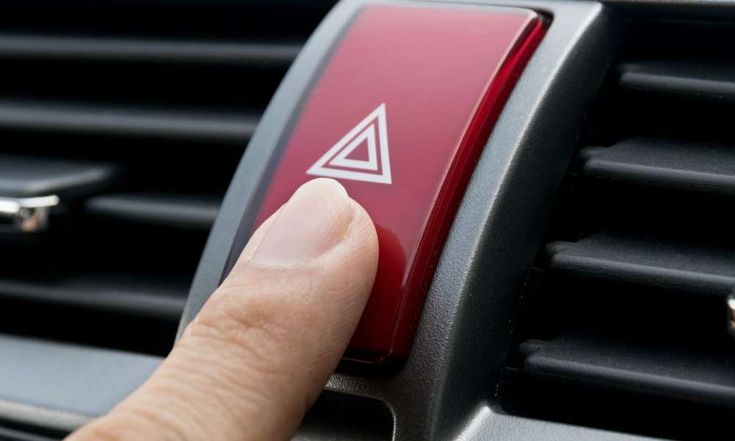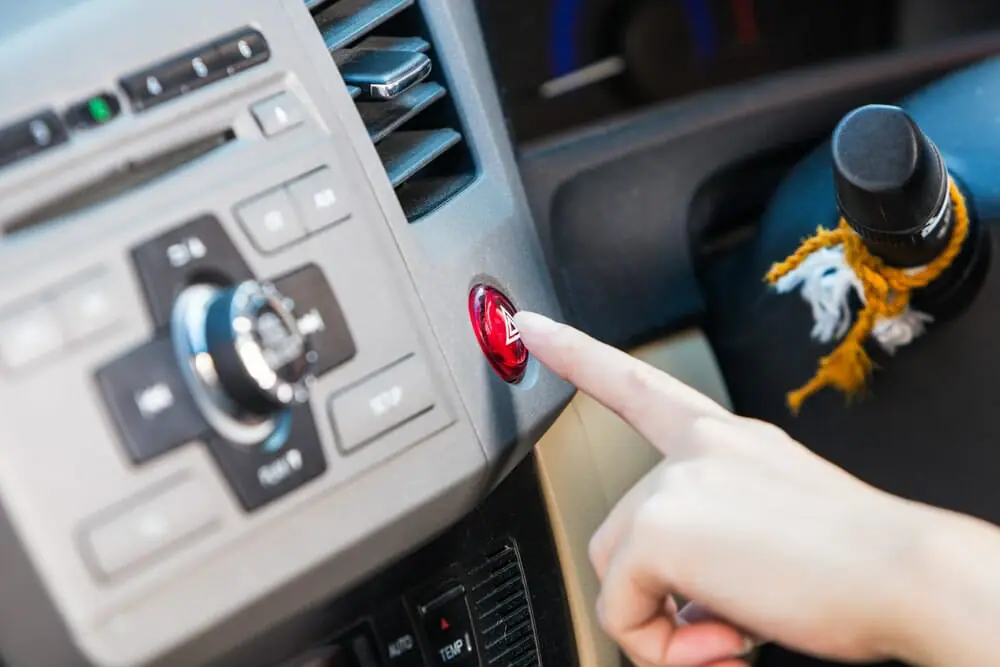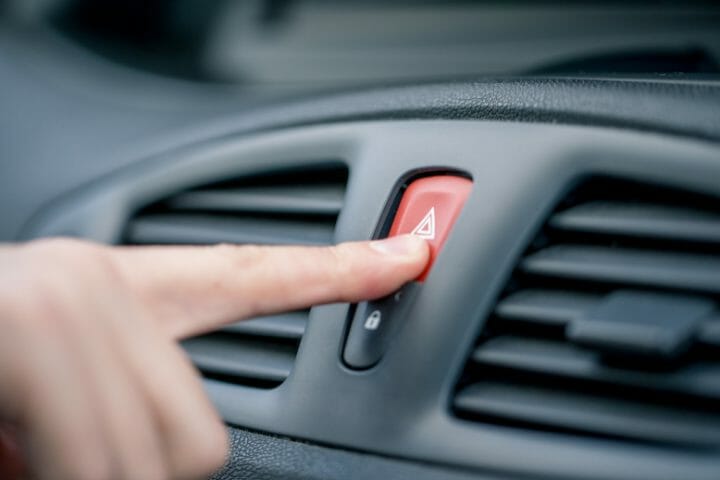Yes, hazard lights do have the potential to drain your car’s battery over time. Like any electrical device, if left on for an extended duration, hazard lights will consume power from the battery.
However, hazard lights are designed to be energy-efficient and consume power at a slower rate compared to other electrical components, such as headlights or the radio.
In general, leaving your hazard lights on for an hour or two may not cause significant battery drain. However, extended use for several hours to a day could lead to a depleted battery, potentially preventing your car from starting. So, It’s advisable to use hazard lights judiciously and not leave them on for extended periods to avoid this situation.
How Hazard Lights Work?

Hazard lights, also known as emergency flashers or four-way flashers, are a vital safety feature in vehicles.
When activated, they cause all four turn signal lights to flash simultaneously, indicating to other road users that your vehicle is temporarily obstructed, experiencing difficulties, or is part of a slow-moving convoy.
Furthermore, they are designed to enhance safety by alerting others to the presence of a potential road hazard.
To use them, you typically engage a dedicated button or switch on your vehicle’s dashboard or steering column.
The functioning of hazard lights involves a simple yet effective mechanism. When activated, they trigger a relay switch that controls the flashing of all four turn signal lights. The relay switch cycles power to the lights on and off, creating a distinctive blinking pattern.
Hazard lights operate independently of the turn signals, so they can function simultaneously. This independent operation is crucial, ensuring that you can use hazard lights even when your turn signals are not functioning correctly.
Hazard lights are versatile and can be invaluable in various situations, from warning other drivers of a stalled vehicle to indicating the presence of a funeral procession or slow-moving construction equipment.
How Long a Car Battery Will Power Hazard Lights?
The duration a car battery can power hazard lights depends on various factors. Primarily, it relies on the condition and capacity of the battery, as well as the efficiency of the hazard light system. In general, hazard lights are designed to use minimal power to prolong battery life, as their primary purpose is to serve as a safety feature in emergencies.
The typical range for hazard light usage on a fully charged car battery can vary from a few hours to a full day. Factors that influence this range include.
Battery Condition
The age and overall condition of the battery play a pivotal role. A brand-new battery or one that has been well-maintained is likely to provide more extended power to the hazard lights compared to an older or less-maintained battery. Regularly checking the battery’s health and charging system can ensure optimal performance.
Hazard Light Type
The type of bulbs used in the hazard lights significantly affects power consumption. In recent years, many vehicles are equipped with hazard lights that utilize energy-efficient LED (Light Emitting Diode) bulbs. LEDs are known for their low power consumption, making them an ideal choice for hazard lights. Traditional incandescent bulbs, on the other hand, consume more power.
Other Electrical Devices
The simultaneous use of other electrical devices, while hazard lights are active, will draw power from the battery. For instance, running the air conditioning or playing music increases the load on the battery and may reduce the time the hazard lights can run.
Environmental Factors
Extreme environmental conditions can impact battery performance. High temperatures can accelerate chemical reactions within the battery, leading to faster energy depletion.
On the othert hand, extremely cold temperatures can reduce a battery’s efficiency, making it less capable of sustaining the hazard lights. It can reduce a battery’s efficiency by up to 50%.
Can Leaving Hazard Lights On Damage My Car Battery?
Yes, leaving the hazard lights on for an extended period can potentially damage the car battery.
Hazard lights, like any electrical device, draw power from the battery. If left on for too long without the engine running, they can drain the battery to a point where it may not have enough power to start the vehicle.
The extent of damage can vary based on factors such as the battery’s condition, the type of hazard lights (LED or incandescent), and other electrical devices in use.
Repeatedly allowing the battery to fully discharge by leaving the hazard lights on can lead to reduced battery life. Modern batteries are designed to handle some discharging and recharging cycles, but excessive deep discharges can shorten their overall lifespan.
However, it’s important to exercise caution and use hazard lights only when necessary to prevent potential damage to the car battery. Regularly checking and maintaining the battery’s health is also advisable to ensure it remains in good condition.
Also, proper care of your car’s electrical system can help extend the life of your battery and reduce the risk of damage from excessive discharging.
When to Use Hazard Lights Wisely?
Hazard lights, also known as emergency flashers, are a valuable safety feature in vehicles, and using them wisely is essential for maintaining road safety. Here are some situations in which it is appropriate and prudent to use hazard lights
Vehicle Breakdown
Hazard lights should be used when your vehicle experiences a mechanical failure, rendering it immobile. This can include engine trouble, a flat tire, or any issue that requires your vehicle to be stationary on or by the road. By activating your hazard lights, you alert other drivers to the presence of a stalled or stopped vehicle and reduce the risk of accidents.
Accident or Emergency Stop
Hazard lights are crucial when you’re involved in a traffic accident or need to make a sudden, unplanned stop. In these situations, activating your flashers can help prevent secondary accidents by indicating that there’s a problem ahead. This is especially vital on highways and busy roads.
Towing or Towed Vehicle
When you’re towing another vehicle, such as a trailer or caravan, or when your vehicle is being towed by another, hazard lights should be used. This communicates to other road users that your vehicle is not operating normally and is part of a towing configuration.
Funeral Processions
Some regions permit the use of hazard lights during funeral processions. In such cases, it signifies that the vehicles involved are part of a coordinated procession, allowing for a respectful and organized tribute.
Pilots on Taxiways
At airports, aircraft may employ their hazard lights when taxiing along the ground. This practice improves visibility for ground personnel and other aircraft during taxi operations.
Legal Requirements
In specific circumstances, legal requirements or local regulations may dictate the use of hazard lights. For example, in the United States, it’s permissible to use hazard lights during inclement weather with low visibility, such as heavy rain, snow, or fog. Always stick to your jurisdiction’s laws to ensure safe and responsible usage.
Remember, hazard lights should be used in a manner consistent with local traffic laws and regulations. Using them inappropriately can cause confusion and even pose risks to other drivers. Always use hazard lights judiciously and turn them off when the situation no longer requires their use to ensure safety on the road.
How Can I Prevent Battery Drain from Hazard Lights?

While using hazard lights is important for safety, it’s equally essential to prevent excessive battery drain.
Use Hazard Lights Sparingly: While hazard lights are essential during emergencies and breakdowns, avoid using them for non-emergencies like double-parking or as a temporary parking indicator. Unnecessary use can expedite battery drain.
Regularly Check Battery Health: Periodically inspect your car battery’s condition. Look for signs of corrosion on the terminals, as this can impede electrical flow. If your battery is old or showing signs of deterioration, consider having it tested or replaced.
Limit Idling: Extended idling with the hazard lights on can deplete the battery. If you find yourself in a situation where you need to idle with hazards, consider turning off the engine intermittently to conserve power.
Properly Inflate Tires: Underinflated tires can cause your vehicle’s engine to work harder, especially at low speeds, increasing the strain on the battery. Regularly check and maintain proper tire pressure.
Moderate Accessory Use: Avoid using multiple electrical accessories simultaneously when the engine is off. High power usage can drain the battery faster. This includes the radio, air conditioning, and interior lights.
Invest in a Maintenance Charger: If your vehicle is frequently parked for extended periods, investing in a maintenance charger or a trickle charger is a good idea. These devices help keep the battery charged without overloading it.
Seek Shade: If you’re parking your vehicle for a while, especially during hot weather, try to find a shaded spot. Extreme temperatures can impact the battery’s performance.
Turn Off Engine Before Hazard Lights: If you need to use hazard lights, make sure the engine is running before activation. This will prevent the battery from shouldering the electrical load alone.
Regularly Drive the Vehicle: If your car sits idle for extended periods, the battery can discharge. Regularly taking your vehicle for drives can help maintain the battery’s charge.
Consider a High-Quality Battery: When it’s time for a battery replacement, consider investing in a high-quality, reliable battery. It may cost more upfront but can be more durable and less prone to quick depletion.
FAQ
What happens if you turn on hazard lights?
When you turn on hazard lights, all four turn signal lights on your vehicle will flash simultaneously. This indicates to other drivers that your vehicle is stationary or in an emergency situation.
What is the difference between hazard lights and parking lights?
Hazard lights are used to indicate an emergency situation or that your vehicle is temporarily stopped on the road. Parking lights are typically used to make your vehicle more visible when parked on the side of the road in low-light conditions. Hazard lights are more intense and flash simultaneously, while parking lights are steady and emit a lower intensity of light.
Do hazards turn on brake lights?
Hazard lights do not activate your brake lights. They are a separate lighting system designed for emergencies or when your vehicle is stationary.
When should you turn on hazard lights?
Hazard lights should be used in situations such as a vehicle breakdown, traffic accident, or when you’re driving significantly slower than the flow of traffic, to warn other drivers of a potential hazard.
Do hazard lights disable brake lights?
Hazard lights do not disable your brake lights. Both lighting systems can operate simultaneously if needed.
How do hazard lights work?
Hazard lights are activated by a switch or button on your vehicle’s dashboard. When turned on, they cause all four turn signal lights (front and rear) to flash in unison to alert other drivers to a potential emergency situation.
Does the handbrake use brake lights?
The handbrake (also known as the emergency or parking brake) does not activate your brake lights unless you engage it while driving, which is not recommended. Brake lights are designed to activate when you apply the foot brake, not the handbrake.
Are brake lights necessary?
Yes, brake lights are essential for road safety as they signal to drivers behind you that you are slowing down or coming to a stop. They provide important information to other road users.
What are automatic hazard lights?
Automatic hazard lights, also known as automatic emergency braking (AEB) hazard lights, are a feature in some vehicles. They activate hazard lights when the vehicle’s automatic emergency braking system engages to warn other drivers that the vehicle is suddenly slowing down due to a potential collision.
Final words
On the whole, hazard lights can indeed drain your car’s battery if left on for an extended period. While they are designed to be more energy-efficient than some other electrical devices, it’s essential to use them wisely and avoid leaving them on for too long to prevent battery drain. Always be mindful of when and why you’re using hazard lights, and take measures to prevent unnecessary battery depletion. By following these guidelines, you can ensure that your battery remains in good condition and ready to power your vehicle when needed.

